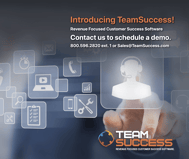That’s according to the Customer Success Association who tells us that being able to prove your worth in both directions is the most crucial aspect of determining success. Monitoring the return on investment (ROI) for the customer is therefore a vital capability, and in the other direction, driving recurring revenues for your company. The CSA advises that Value Management functionality should also include:
- Deep churn analysis and reporting,
- Tracking and reporting on up-sell and cross-sell potentials and actuals, and
- Analysis of sales pricing, commitments and deal quality.
Where does your customer support team fit in? Historically, B2B customer support departments have not been thought of as revenue generating. But for many technology companies, 70% or more of revenue comes from existing customers.1 That means that “customer satisfaction” is no longer enough. And the newly formed “customer success” function must work in synergy with Support to drive recurring revenue. And there must be a shift out of reactive mode and into far more effective proactive stances by gathering and using the data from every interaction to inform this approach.
In this blog series, we will explore the three ways to achieve success for your customers…and for your bottom line.
Ensure Product Adoption and Use
The new report by ServiceXRG introduces the concept of how well-defined service programs and effective adoption of your product can be the keys to maximizing recurring revenue performance. “Customers buy products to enable and streamline their business operations. Services drive recurring revenue by helping customers to successfully adopt and apply products.”2
But what does this mean, exactly? We all know that the cost of acquiring new customers is much greater than what it costs to retain existing ones. But did you also know that a 5% decrease in monthly churn can result in 50% more revenue over a five-year period?
The best way to protect and expand your core business is to ensure your customers are succeeding with your product. If they do not fully use what they have already purchased, or if the perceived support users receive post-sale, beginning with onboarding, is less than positive, there is little likelihood they will purchase more or even renew current subscriptions.3
It’s obvious that the customer needs the features and benefits your product provides—you determined that through the sales journey—yet features are irrelevant if customers do not or cannot use the product to achieve their desired business outcomes.
- Start by offering a comprehensive, personalized onboarding process that includes all users.
- Hold regular and ongoing product training programs, such as TeamSupport’s monthly TeamSupport University webinars.
- Build a robust Knowledge Base of articles that enable self-help and can be used by your agents to supplement resolving tickets.
Remember, the quicker all users in your B2B customers’ support organization adopt your product and use it to its full benefit, the more likely they will recognize it as mission critical, and exponentially increasing the likelihood of renewing.
In Part 2 of this series we’ll address how to use B2B customer support tools to proactively strengthen your customer relationships and reduce churn.

|
With increasing revenue as its primary focus, TeamSuccess boldly repositions the role of B2B customer success software in the industry. TeamSuccess allows customer success teams to easily monitor, automate, and streamline the customer lifecycle, creating more upsell opportunities, reducing the risk of churn, and ensuring that as customer relationships grow, so do contributions to the bottom line. Learn more at TeamSuccess.com. |
Looking For Startup Consultants ?
Call Pursho @ 0731-6725516
Telegram Group One Must Follow :
For Startups: https://t.me/daily_business_reads







